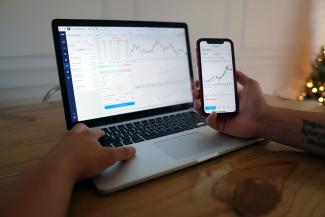
Volatility Continues
Dear Valued Investor,
2022 has been a challenging year for investors so far. The S&P 500 Index just had one of its worst Aprils in decades, and May is off to a rocky start. Bond investors have not fared much better as rising interest rates have pushed down bond prices. Bond losses have made the stock market volatility feel even worse than usual. Markets don’t like uncertainty but it’s getting a healthy dose of it this year, dealing with high inflation, tighter Federal Reserve monetary policy, COVID-19 shutdowns in China, and snarling global supply chains, all while the war in Ukraine continues.
Investing mistakes often take place during periods of elevated volatility. One of the most frequent is trying to time the market by jumping in and out. Market timers must be right twice and timing the return to the market can be extremely difficult to pull off. Markets can turn quickly, and missing even just one big up day can significantly reduce returns over time. The biggest daily gains tend to come in down markets, making them especially difficult to predict. Time in the market, not timing the market, may be more beneficial to long-term investors.
When markets are shaky, it can be helpful to look to long-term fundamentals that have provided the foundation of positive returns for stocks and bonds over the long run. For stocks, gains depend on the ability of corporations to grow earnings, which they have continued to do during first-quarter earnings season—S&P 500 Index earnings per share are on track to increase 10% year over year. For bonds, the key fundamental has simply been the ability of borrowers to make required payments. Corporations and consumers enjoy strong balance sheets and have the financial firepower to pay their debts. While the future is always uncertain, we believe those fundamentals remain in place.
Even against a potentially supportive fundamental backdrop, the volatility we’ve seen in stocks this year is not unusual. Although negative returns for a full calendar year are infrequent, corrections are fairly common. Since 1980, the S&P 500 has been negative for a calendar year just seven times, but the average decline within any year has been 14%. Mid-term election years have tended to see increased early year volatility, as the honeymoon period for a new president ends and political uncertainty rises. Inflation can also be challenging. Years with inflation over 5% have seen more frequent stock market declines than a typical year, but stocks have still been higher more often than not.
Amid the global economic and geopolitical uncertainty, the core domestic economy is still quite stable. Weekly consumer spending data is above typical baseline levels. Job seekers are participating in a tight labor market with twice as many openings as unemployed people. Businesses are enjoying high-profit margins despite cost pressures. The economy is expected to grow in the latter part of this year after a surprise contraction in the first quarter, though the growth path may be bumpy as monetary policy is recalibrated from exceedingly loose to moderately tight and consumers and businesses adjust to higher borrowing costs. Our base case is still for above-trend economic growth in 2022.
We believe patient investors stand a better chance of meeting their long-term goals. No one has a crystal ball, but at lower valuations, history suggests the chances of above-average returns going forward may be rising. It’s tough to do during times like this, but we encourage long-term investors to stick to their game plan.
Please contact me if you have any questions.
Sincerely,
Shane Terry, ChFC®
President & LPL Registered Principal
Terry Wealth Management
2710 Loker Avenue West
Suite 220
Carlsbad, CA 92010
Phone/Fax 760.858.2080
CA Insurance Lic. #0K26885

